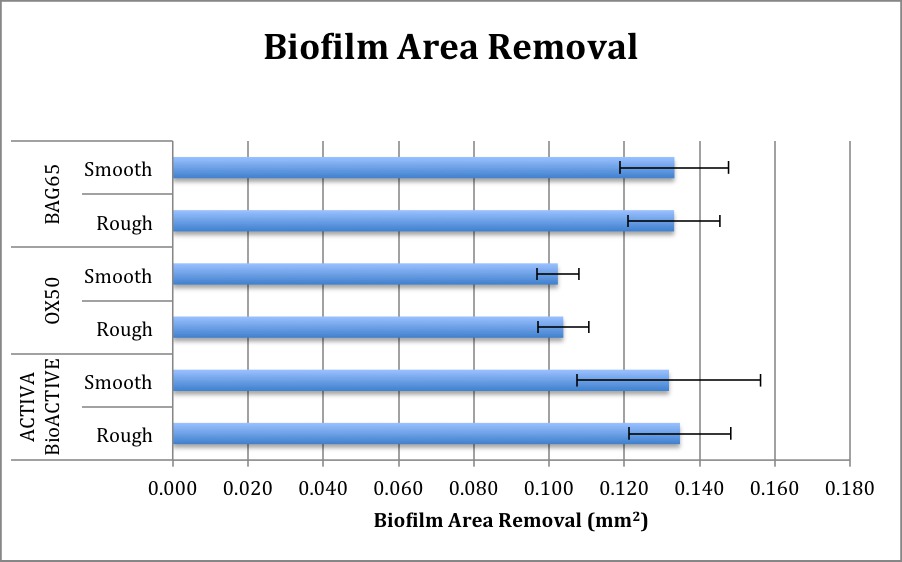IADR Abstract Archives
Adhesion of S. Mutans Biofilms on Potentially Antimicrobial Dental Composites
Objectives: The objective of this experiment was to compare the adhesive strength of S. mutans biofilms grown on dental composites having potential antibacterial additives using a microjet impingement (MJI) method. The extent to which surface roughness affected adhesion was also measured.
Methods: Disk-shaped specimens (10-mm diameter x 2-mm) were made from two experimental composites with 50:50 Bis-GMA/TEGDMA, designated OX50 (Sr glass and 15% OX50 nanosilica) and BAG (Sr glass and 15% Bioactive Glass containing 65 wt% SiO2, 31 wt% CaO, and 4 wt% P2O5), and one commercial composite (ACTIVA BioACTIVE, Pulpdent). Specimens were metallurgically ground to produce smooth (Ra<0.1μm) and rough (Ra>0.4μm) surface finishes (TR200, TIME Group). Specimens were independently in wells containing TSB+0.5% (wt/vol) sucrose inoculated with 1:100 UA159 Streptococcus mutans (OD600=0.3) for 24 hours at 37°C, 5% CO2. Biofilm adhesion strength was quantified by the microjet impingement (MJI) method. A 0.20-mm ID nozzle was oriented perpendicular to the disk-shaped specimens at a height of 0.4-mm and dispensed a stream of phosphate-buffered saline (PBS) for 5 seconds at 40 psi. Impingement parameters were standardized in a pilot test. Biofilms (n=10) were stained with crystal violet and imaged by light microscopy. ImageJ software was used to determine the area of removed material from each biofilm, indicative of loss of adhesion. Groups were compared with 2-way ANOVA/Tukey’s (α= 0.05).
Results: Statistically similar biofilm removal was achieved with the BAG and ACTIVA composites, but both were greater than the OX50 composite (Figure). There was no significant difference in area of biofilm removal for the two different surface roughnesses.
Conclusions: While S. mutans biofims formed on composite materials containing potentially antimicrobial agents, BAG65 and ACTIVA, these biofilms were less strongly attached and more easily disrupted by shear forces, independent of surface roughness.
Methods: Disk-shaped specimens (10-mm diameter x 2-mm) were made from two experimental composites with 50:50 Bis-GMA/TEGDMA, designated OX50 (Sr glass and 15% OX50 nanosilica) and BAG (Sr glass and 15% Bioactive Glass containing 65 wt% SiO2, 31 wt% CaO, and 4 wt% P2O5), and one commercial composite (ACTIVA BioACTIVE, Pulpdent). Specimens were metallurgically ground to produce smooth (Ra<0.1μm) and rough (Ra>0.4μm) surface finishes (TR200, TIME Group). Specimens were independently in wells containing TSB+0.5% (wt/vol) sucrose inoculated with 1:100 UA159 Streptococcus mutans (OD600=0.3) for 24 hours at 37°C, 5% CO2. Biofilm adhesion strength was quantified by the microjet impingement (MJI) method. A 0.20-mm ID nozzle was oriented perpendicular to the disk-shaped specimens at a height of 0.4-mm and dispensed a stream of phosphate-buffered saline (PBS) for 5 seconds at 40 psi. Impingement parameters were standardized in a pilot test. Biofilms (n=10) were stained with crystal violet and imaged by light microscopy. ImageJ software was used to determine the area of removed material from each biofilm, indicative of loss of adhesion. Groups were compared with 2-way ANOVA/Tukey’s (α= 0.05).
Results: Statistically similar biofilm removal was achieved with the BAG and ACTIVA composites, but both were greater than the OX50 composite (Figure). There was no significant difference in area of biofilm removal for the two different surface roughnesses.
Conclusions: While S. mutans biofims formed on composite materials containing potentially antimicrobial agents, BAG65 and ACTIVA, these biofilms were less strongly attached and more easily disrupted by shear forces, independent of surface roughness.

